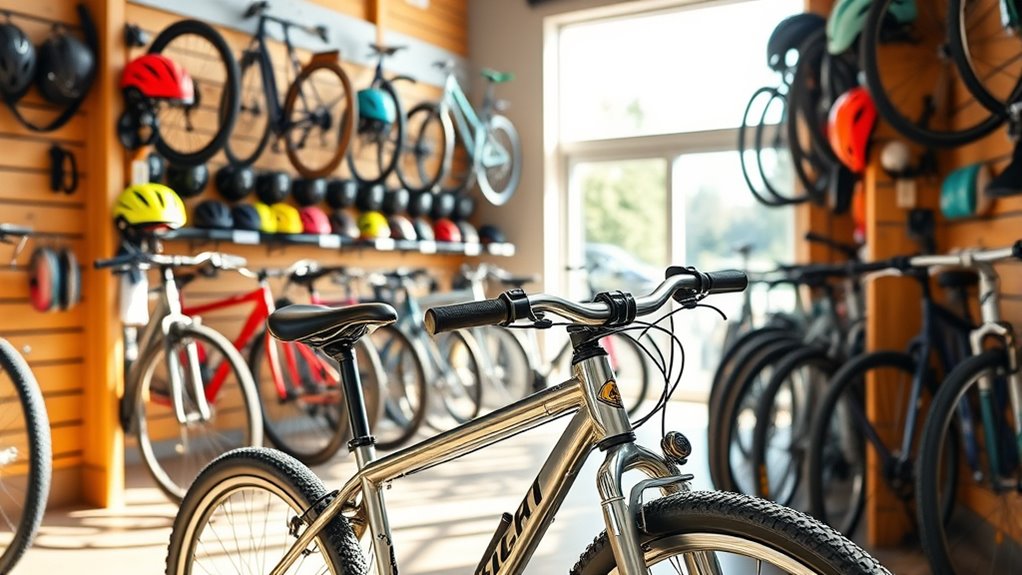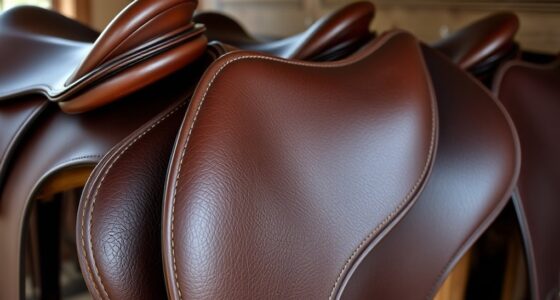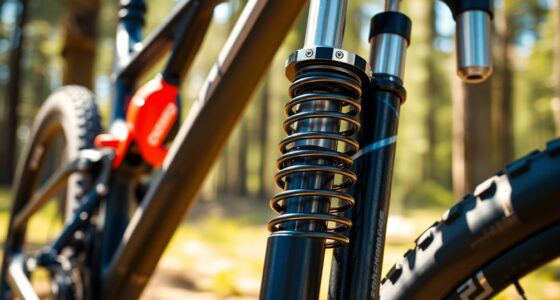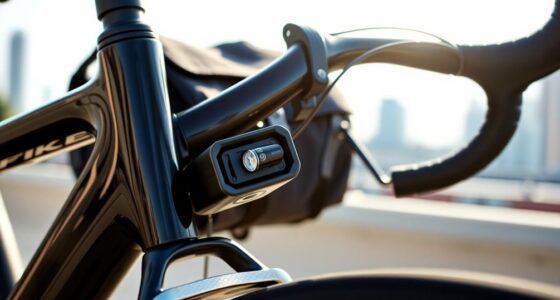To choose your first bike, start by considering where you’ll ride most—commutes, trails, or casual outings—and pick a model suited to that purpose. Make sure the bike fits well by standing over the top tube with a small clearance and adjusting the saddle for a slight knee bend. Set a realistic budget that balances quality and safety features, including essential gear. If you want to know more tips for finding the perfect beginner bike, keep exploring options and advice.
Key Takeaways
- Determine your primary riding purpose (commuting, trail, casual) to select the appropriate bike type.
- Ensure proper bike size and fit by standing over the top tube and adjusting saddle height for comfort.
- Set a realistic budget, prioritizing quality components and safety features for long-term value.
- Research local bike shops and resources to test models, compare options, and understand maintenance needs.
- Choose a simple, reliable bike and learn basic maintenance skills to ensure safety and ease of upkeep.

Getting your first bike is an exciting step, but choosing the right one can feel overwhelming. With so many options available, it’s easy to get lost in the details and second-guess your choices. The key is to focus on what fits your needs, skill level, and budget. Start by considering where you’ll ride most often. Are you planning to cruise around your neighborhood, hit the trails, or commute to work? Your primary use will influence the type of bike you should choose. For city riding and short commutes, a hybrid or city bike might be ideal—these bikes are comfortable, lightweight, and easy to maneuver. If you’re interested in exploring trails or off-road adventures, a mountain bike with sturdy tires and suspension will serve you better. For casual rides and beginner-friendly options, a simple cruiser bike with wide tires and a relaxed frame can be a good choice.
Next, think about your body size and fit. Riding a bike that’s too big or small can make handling difficult and cause discomfort or even injury. To determine the right size, stand over the top tube of the bike; there should be at least a 1-2 inch clearance for safety and comfort. When sitting on the saddle, your leg should be slightly bent at the knee when the pedal is at its lowest point. Don’t hesitate to visit a local bike shop to get properly measured and try different models. The staff can help you find a bike that feels comfortable and suits your size. Additionally, researching tiny house resources can give you insight into how to customize or modify bikes for specific needs or preferences. Understanding personal development principles, such as setting achievable goals, can also help you stay motivated during your biking journey. Moreover, learning about financial management can assist in planning your budget for accessories and maintenance to ensure long-term satisfaction with your purchase. Also, exploring marketing strategies for cycling gear can help you find the best deals and stay informed about new products.
Budget is also a vital factor. While it’s tempting to go for the cheapest option, investing a bit more can mean better quality, durability, and safety features. Look for a bike that offers good value—quality components, reliable brakes, and lightweight materials matter more than flashy accessories. Keep in mind that you’ll also need essential gear like a helmet, lights, and a lock, which should be factored into your overall budget.
Finally, consider the maintenance and ease of use. A bike with simple, reliable components will be easier to keep in good shape. Ask about warranty options and local repair services. When you finally pick your bike, take the time to learn basic maintenance skills, like fixing a flat tire or adjusting brakes. This knowledge will help you keep your bike in top condition and guarantee safe, enjoyable rides for years to come.
Frequently Asked Questions
What Safety Gear Should I Start With?
When selecting safety gear, start with a well-fitted helmet to protect your head. Wear comfortable gloves to improve grip and protect your hands. Invest in reflective clothing or strips to increase visibility, especially at night. Consider knee and elbow pads to prevent injuries during falls. Always prioritize quality gear that fits properly, so you stay safe and confident while riding. Remember, safety gear is essential for every ride.
How Often Should I Maintain My Bike?
You might find it surprising, but how often you maintain your bike really depends on how often you ride. If you ride daily, check your tires, brakes, and chain weekly. For occasional riders, a monthly inspection suffices. Regular maintenance prevents breakdowns and extends your bike’s lifespan. Always keep an eye out for unusual noises or sluggish responses—these signs mean it’s time for a quick tune-up. Staying proactive keeps your rides smooth and safe.
Can I Ride a Bike on All Terrains?
You can ride a bike on various terrains, but it depends on the bike you choose. Mountain bikes are designed for rough trails and dirt paths, while road bikes excel on pavement. If you want versatility, consider a hybrid bike that handles both. Keep in mind, riding on uneven or rugged terrain may require specific features like wide tires or suspension. Match your bike to the terrains you’ll most often encounter for the best experience.
What’s the Best Way to Learn Bike Maintenance?
You might think learning bike maintenance is a tiny task, but it’s actually a wild adventure that can transform your riding experience! To master it, start by watching online tutorials and reading your bike’s manual like a detective hunting clues. Practice basic skills like fixing a flat or lubing chains regularly. Join a local bike workshop or ask experienced riders for hands-on tips—they’ll help you become a maintenance pro in no time!
How Do I Choose the Right Bike Size for Me?
To choose the right bike size, you need to take into account your height and inseam measurement. Stand over the bike frame; you should have 1-2 inches of clearance for road bikes or 3-4 inches for mountain bikes. Test ride different sizes if possible, and focus on comfort and control. Proper sizing ensures a smooth ride and reduces fatigue, making your cycling experience enjoyable from the start.
Conclusion
Now that you’ve navigated the nuances of selecting your first bike, it’s time to take the leap. Remember, with patience and planning, you’ll find the perfect fit that fuels your freedom and fuels your fun. Trust your taste, test your style, and embrace the excitement of starting your cycling journey. Gear up, get going, and watch your confidence climb as you conquer roads and trails alike. Your biking beginning is just a pedal away!









